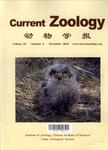Biparental behavior in the burying beetle Nicrophorus orbicollis: a role for dopamine?
Biparental behavior in the burying beetle Nicrophorus orbicollis: a role for dopamine?作者机构:Department of Biology UniversiW of Nebraska at Keamey Kearney NE 68849 USA Department of BiologyUniversity of South Dakota Vermillion SD 57069 USA
出 版 物:《Current Zoology》 (动物学报(英文版))
年 卷 期:2016年第62卷第3期
页 面:285-291页
核心收录:
学科分类:0710[理学-生物学] 07[理学] 071006[理学-神经生物学] 071002[理学-动物学]
基 金:funded by a RSC grant (SCP) a URF award (JPS) from the UNK's Office of Undergraduate Research & Creative Activity by National Science Foundation a Center for Brain and Behavioral Research pilot Grant, USD (KJR)
主 题:dopamine Nicrophorus neuromodulation octopamine parental care serotonin.
摘 要:Burying beetles Nicrophorus orbicollis exhibit facultative biparental care of young. To reproduce, a male-female burying beetle pair bury and prepare a small vertebrate carcass as food for its altricial young. During a breeding bout, male and female behavior changes synchronously at appropriate times and is coordinated to provide effective care for offspring. Although the ecologicaJ and evolutionary factors that shape this remarkable reproductive plasticity are well characterized, the neuromodulation of parental behavior is poorly understood. Juvenile hormone levels rise dramat- ically at the time beetle parents accept and feed larvae, remain highly elevated during the stages of most active care and fall abruptly when care is terminated. However, hormonal fluctuations alone cannot account for this elaborate control of reproduction. The biogenic amines octopamine (OA), dopamine (DA), and serotonin (5-HT) mediate a diversity of insect reproductive and social behav- iors. In this study, we measured whole brain monoamine levels in individual male and female bury- ing beetles and compared OA, DA, and 5-HT profiles between breeding (parental) and nonbreed- ing, unmated beetles. Remarkably, after 24 h of care, when parental feeding rates begin to peak, DA brain levels increase in breeding beetles when compared to nonbreeding controls. In contrast, brain OA and 5-HT levels did not change significantly. These results provide the first evidence for a potential role of DA in the modulation of burying beetle parental behavior.



